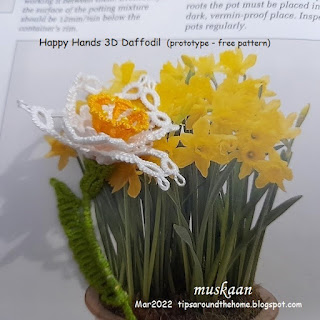ch-1: 1 - 4 - 6, tw SS
ch-2: - 4 - 6 LJ 4 LJ, tw SS
ch-3: [ 1 - 4 LJ 6 LJ, tw SS
ch-4: 4 - 6 LJ 4 LJ, tw SS ]x6
Make one last chain and remember to join it to BOTH the 1st and previous chain at 2 points respectively. This creates a conical structure, with both threads emerging along the top edge. Continue ...
Victorian Set Chain: [ 3fhs 3shs 3fhs 3shs, LJ ]x7
TIP: We can add a 2nd row for a wider and more pronounced frill. This could be with sets of 4 or 5 half stitches each.
Anthers : Each is made separately with a bead at the tip of a lock chain. Use leftover thread, short lengths are sufficient, and single shuttle. String bead and work the lock chain below it. You can decide the length of each stamen. I varied the lengths using between 6 to 9 lock stitches, for 4 stamens.
Calyx : Block tatting. Start with a paper clip to hold picot or a lock stitch (without paperclip, which is what I did here). 2 shuttles, ctm.
ch-1: - 6 - 4, tw SSch-2: - 2 - 4 LJ 6 LJ, tw SSch-3: 1 half-stitch - 6 LJ 4 LJ, tw SS
ch-4: 2 - 4 LJ 6 LJ, tw SS
ch-5: 1 half-stitch - 6 LJ 4 LJ, tw SS
ch-6: - 2 - 4 LJ, tw SS
ch-7: 4 LJ, tw SS
Repeat chains 2 & 3 twice. Wrap the open calyx around all the tails at the base of the petals. Make one last chain joining to BOTH 1st and last chain at both joining points so that we have a cone.
Lock Chain encapsulation : Always keep the tail ends encapsulated while making each half-stitch. Make unflipped shs, slightly rotate the stalk towards you, make a manoeuvred fhs, rotate stalk back to original position, and repeat this process for the desired length.
ring: 4 - 6. Before closing, pull all tails through this ring and adjust the position.ch-1: [ 1 - 3 LJ(to ring) 1, tw SSch-2: 1 - 4 LJ, tw SS ]x10-12folded ring: 8 - 2fhs 8 2shs.
The stalk is semi-stiff and when held at the base of the leaf, it can hold the flower up. I have not done any kind of finishing here. This entire flower is as it is when it came off my shuttles.
A side view with displaced leaf. Yes, as I said in the beginning, this is a prototype and I have made several mistakes besides not being as neat as I would've liked. But hubby really likes it and I am happy for now.
Worked entirely with Anchor Pearl Cotton size 8. The flower spans 5cms, and the complete sprig is 8cms high; leaf is 4.5cms high.
















































